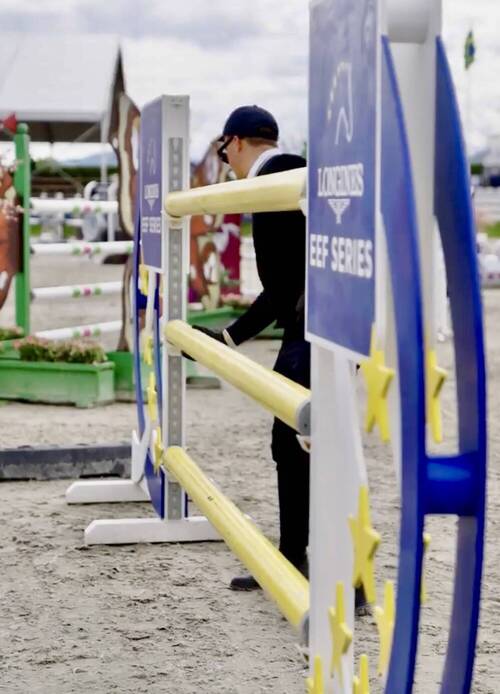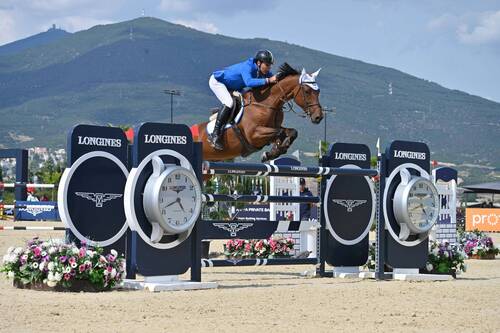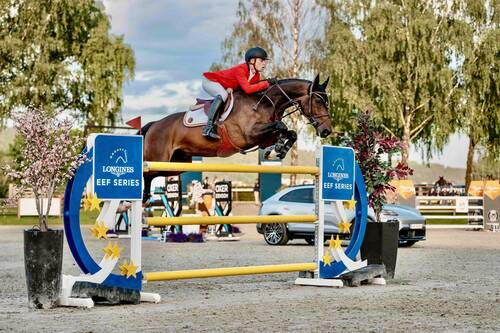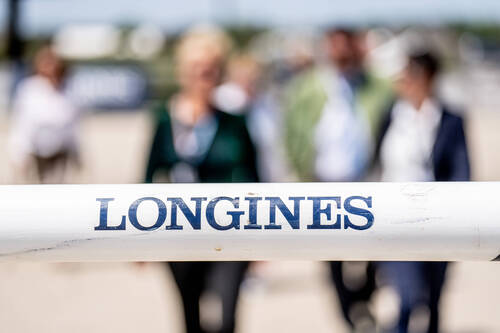The Science and Strategy Behind Showjumping Course Design
15. Aug 2025 / Category: Press Release
Report: Eleanore Kelly
In showjumping, victory hinges not only on the athleticism of horse and rider but also on the ingenuity of the course designer. Behind every clear round and every heart-stopping rail lies a meticulously crafted sequence of jumps, turns, and distances—an intricate balance between sport, safety, and spectacle.
At the upcoming Longines EEF Nations Cup Final in Avenches, that balance will be in the hands of Swiss course designer Gérard Lachat. With more than a decade of international experience, Lachat approaches each arena as a blank canvas. “The creativity, looking for interesting layouts and the relationships with people- course builders, riders, trainers- that’s what I love about my job,” he says.
Designing for Safety, Challenge, and Excitement
For Lachat, safety is always the starting point. “First and foremost, the safety of the horses and riders,” he explains. “Then the course has to be interesting for the riders and enjoyable for the spectators to watch.” He carefully calibrates distances to the level of the competition, aiming to “encourage small mistakes rather than refusals,” ensuring that challenges come from precision and decision-making, not danger.
This balance is echoed by Belgian course designer Bart Vonck, who built for the EEF Nations Cup legs in Drammen and Peelbergen this season. A former rider himself, Vonck knows that the difference between a fair test and a punishing one often comes down to fine margins. “We don’t want riders to be eliminated or withdraw,” Vonck stresses. “We like to see riders with one fault. Even 2 or 3 cm in height and 10 cm in width can make a big difference.”
Vonck likens course designers to “architects of everything in the arena,” considering not just the jumps but also arena decoration, colours, water jump placement, and even visual elements and branded items such as cars in the ring. Each decision shapes how horses read the course and how riders strategise their approach.
Andy Bamberger has been designing international courses for 10 years and builds the EEF Nations Cup course in Thessaloniki. “I always ask myself the question ‘for what and for whom I am building the courses’; ‘What should be the aim and what is the future plan.’ And here for the EEF Series are a very good tool. I built now for the third time in a row the Nations Cup in Greece and for me there is a long term plan in the region. Three years ago we start with a ‘normal’ course and every year I add more and more questions, because the riders are developing. So for me I see it more as a positive challenging between riders and course designer.”
Reading the Field
An essential skill for any top-level course designer is adaptability. No two events are the same- venue size, weather, footing, and the calibre of the competitors all influence the final design.
Lachat is factoring in Avenches’ “classic arena with good quality sand” for the Longines EEF Nations Cup Final, which he says “should not affect the horses’ galloping ability.” Still, as a championship, he plans for a tougher test than the qualifying rounds: “It will definitely be more difficult, a more technical course. I hope there will be some changes in the rankings between the first and second rounds and that there will be suspense until the end.”
Vonck takes a similarly responsive approach when designing. “If we look at the starting list and see there are a lot of riders jumping 1m50 for the first time, we can slightly adjust to have a good result at the end of the class,” he says. His goal is to distribute faults evenly throughout the course, ensuring no single fence dominates the outcome.
The Evolution of Course Design
Showjumping has changed dramatically over the past decades. Both Lachat and Vonck point to advances in horse training, conditioning, and breeding as key drivers. Today’s horses are faster, more agile, and more careful than ever before.
“Horses have become better, more sensitive, more respectful and more spirited,” says Lachat. “We have made the courses much lighter, more technical and more delicate for the safety of the horses.”
“The biggest change is for sure the length of the stride” says Bamberger “I think we are now on a point where the stride of the horse comes to a maximum. So we have to be careful with this issue and try to find a way to consider this in our future courses”
Vonck agrees that the horses’ strides have evolved, changing the way distances between fences are calculated. “The sport is much more delicate because the horses are so good and have so much respect for the fences nowadays,” he explains. “They are top athletes.”
This refinement means that modern course design often demands more from riders tactically. The days of simply galloping down long lines are gone; today’s riders must think quickly, adjust instantly, and maintain absolute precision from start to finish.
The Role of Footing and Conditions
Arena surfaces may not be the most glamorous element of the sport, but footing plays a critical role in both performance and safety. “The terrain mainly influences distances,” Lachat explains. “If it is hard or very soft, the horses will not take the same stride length.”
Vonck is equally attentive to footing, warning that a poorly matched distance on bad ground can be disastrous. Before building, he evaluates weather forecasts, surface type, and how those factors may interact with his planned lines and combinations.
For Bamberger, he sees it as the Designer’s responsibility to ‘take the right action if we don’t find the best circumstances. This is our benefit over using AI in the future, because the Course Designer you always have an eye on the horse’s health so that they can do their best performance.”
Creativity Within Constraints
The best course designers find ways to keep competitions fresh, even within standard height and spread requirements. Lachat says he is always searching for “new layouts” and constantly challenges himself to improve. Whilst Bamberger takes inspiration from a variety of sources: “Sometimes buildings give you an idea about a new material or landscapes an idea of a new line. Also communications with riders and other Course Designers.”
Vonck agrees, adding that variety is crucial for the sport’s evolution. “Yes, course designers each have their own way of course designing and that is very important because we need very different courses and that keeps everyone awake,” he says.
For the EEF Nations Cup series, which sits between national and top-tier five-star events, this creativity is particularly important. The circuit has become a proving ground for emerging talent. “I have seen a lot of good riders starting two or three years ago in the EEF circuit and building their way up to four and five-star competitions,” Vonck notes.
Building for Big Moments
While any international course brings its pressures, designing for a final brings added intensity. The riders are hungry for victory, the stakes are higher, and the atmosphere is electric.
Lachat embraces the challenge. “It’s a final, so there are always higher expectations from the riders, who all want to win, so there’s a little more pressure for me,” he says. His goal in Avenches is to create a contest that builds drama throughout, keeping spectators guessing until the last horse crosses the finish.
Vonck, too, relishes big-stage builds. He recalls Peelbergen as “a super show” and an ideal venue for top sport, while Drammen, hosting his first EEF event there, brought a different mix of riders from Northern Europe, requiring subtle adjustments to suit the field.
The Art Behind the Science
From the outside, showjumping course design may seem purely technical—measurements, heights, and angles plotted on paper. But as Lachat and Vonck make clear, it is as much art as science. A successful course challenges without punishing, rewards precision and adaptability, and creates moments of excitement and tension for riders and spectators alike.
As Lachat puts it: “Inspiration comes when I start drawing the plans, but also when I watch horses jumping at other competitions. I think to myself that certain lines would be good to incorporate into my courses.”
Vonck sees it similarly: “It’s really the whole package… There’s a lot to think about and it takes a lot of time to design the top courses.”
Bamberger believes the role of the Course Designer is becoming more challenging to find the balance between difficulty and fairness, but for the right reasons. “It is more difficult to find the balance. Training of riders is getting better and nowadays they have training plans (for themselves). As an example, who expected 15 years ago that a rider would go to a gym or do sports exercises.”
When the Longines EEF Nations Cup Final unfolds in Avenches, every stride, every turn, and every jump will be the result of weeks of careful thought and creative vision. The riders may take the spotlight, but the one who helps steer the drama is the course designer, part scientist, part artist, and part storyteller.
Where to Watch and Follow
Full results from the regional qualifiers and semi-finals of the Longines EEF Series 2025 season can be viewed here.
For the latest updates, team announcements, and behind-the-scenes content throughout the 2025 Longines EEF Series, follow the Longines EEF Series website and the European Equestrian Federation. Join the conversation on the Longines EEF Series social media on Instagram and Facebook.
For further information on the series final check out the official website of the Longines EEF Series Final Avenches 2025 and follow on Instagram and Facebook.
Download the Longines EEF Series press kit here
Watch the all the live action on ClipMyHorse.TV, the official livestream partner of the Longines EEF Series.






